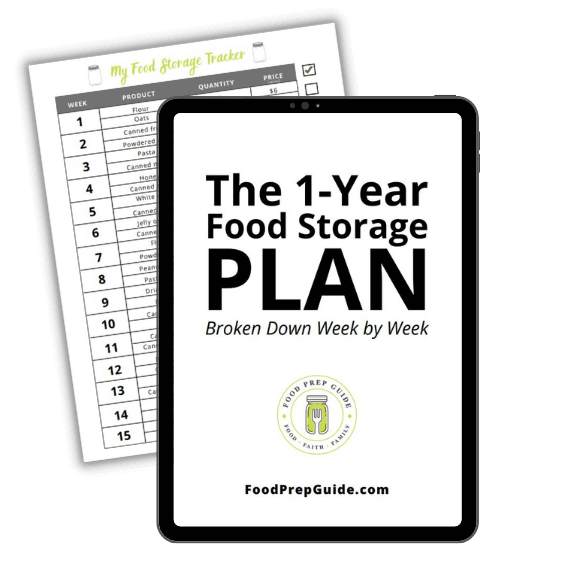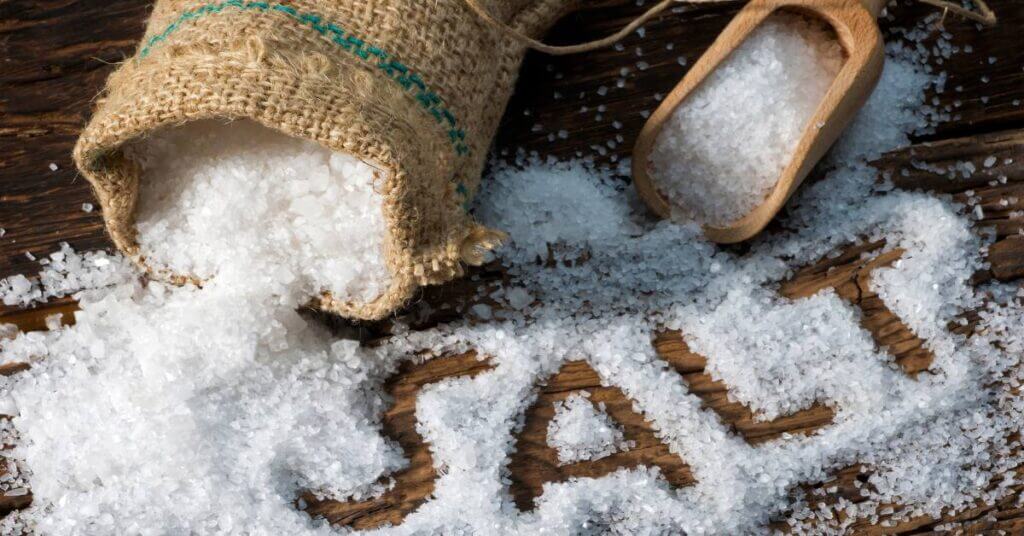My husband and I recently embarked on a fitness challenge that involves drinking more water (and way too much walking, but that’s another story!).
After he got a little dizzy and floaters appeared in his vision, his doctor advised him to increase his salt intake.
Increase salt? Really?
That surprising advice led me to think (and now write) about the importance of storing salt long term.
Why Store Salt Long Term?
A better question would be … why not store salt long term?
As an essential commodity that’s readily available and a breeze to store, there’s no reason your long-term food stores shouldn’t include as much salt as possible.
1. It’s Necessary for Life
For one thing, human beings cannot live without salt (sodium). While we’ve been told that too much salt is harmful, too little can be just as bad, as my husband experienced.
Sodium keeps your nerves firing smoothly, allows your heart to beat rhythmically, and maintains proper hydration through the electrolyte balance in your body.
When we don’t get enough salt, we’re at risk for symptoms like confusion, headaches, dizziness, and much worse.
Salt is also useful for non-life-threatening medical purposes, such as wound care and saline rinses.
(Ever try to rinse your nose or contacts with plain water? Yikes!).
By the way, animals need salt for life, also, so if you have any animals be sure to account for their needs when bulk storing salt.
2. It’s a Natural Food Preservative
Salt is also a natural way to preserve food. For thousands of years, people have used salt to cure food that would spoil otherwise.
Salt draws the moisture from food, depriving bacteria and other toxins the water they need to survive.
Sure, you may never plan to preserve food this way while your refrigerator and freezer are running properly, but there could be a time when you’ll need ways to keep meat and other foods safe to eat sans electricity.
3. It Gives Bland Foods Flavor
Salt makes food taste good. Period.
One reason it’s so hard to cut back on salt when you’ve been eating too much is that salt enhances everything!
Even foods we don’t think of as being savory can benefit from a bit of salt. If you don’t believe me, try putting a pinch in your hot chocolate. Delicious!
If you’re putting away food primarily for hard times and not just for budgetary considerations, you may think flavor won’t be important.
After all, the point is to keep from starving, not enjoy 5-star gourmet meals, right?
But think about this:
How tough will it be to get your children to eat basic, bland foods in an emergency setting where everyone is stressed and their favorite foods are no longer an option?
That little bit of flavor may be the key to getting your kids to eat anything at all—especially your picky eaters.
FREE FOOD STORAGE PLAN!

Does gathering and storing a year’s worth of food for your family seem overwhelming and unachievable?
Make it easy with our step-by-step plan. Subscribe to our weekly newsletter & we’ll send it to you FREE!
Best Types of Salt for Long Term Storage
It’s pretty clear that salt should be a staple in your long-term food pantry.
But what kind of salt?
When you’re shopping for a long-term food storage salt, you’ll want to consider how your family eats currently, along with what their needs and wants may be in a situation where food supplies are compromised.
Additional points to consider include:
- Which salts store the best,
- What nutritional needs your family may have,
- How readily available salt may be in the future,
- What methods you may be forced to use in a disaster situation to keep safe, edible food on your table.
Let’s at a few common types of salt in light of these points.
For Nutrition and Flavor: Sea Salt
First, let’s talk about sea salt. You may or may not already use sea salt on a regular basis.
I know we do. I purchase Celtic sea salt in bulk to save money and so it’s always on hand.
Prices pulled from the Amazon Product Advertising API on:
Product prices and availability are accurate as of the date/time indicated and are subject to change. Any price and availability information displayed on [relevant Amazon Site(s), as applicable] at the time of purchase will apply to the purchase of this product.
Sea salt requires less salt to add more flavor to our food, and it contains trace minerals our bodies need.
Like sugar, there are different “grinds” of sea salt, from coarse crystals to almost powdered (which is fantastic on popcorn!).
Flaky sea salt is similar to kosher salt and is perfect for those times when you need salt to dissolve easily.
Being a pure salt with no additives in its natural form, sea salt stores beautifully.
Yes, salt is easy to preserve, but additives in salt can be a different story.
That’s why it’s important to have a good supply of pure salt—like sea salt—in your food stores.
For Budget: Iodized Table Salt
Sea salt is nutritious, but it can be a bit on the pricey side.
The best salt for saving money is plain old iodized table salt—the kind many of us grew up using before all those “fancy” salts were on the grocery store shelves.
Prices pulled from the Amazon Product Advertising API on:
Product prices and availability are accurate as of the date/time indicated and are subject to change. Any price and availability information displayed on [relevant Amazon Site(s), as applicable] at the time of purchase will apply to the purchase of this product.
Why is most table salt iodized?
Back in the early 1900’s, iodine deficiency was a thing, especially in far-flung parts of rural America.
In an attempt to bring iodine to everyone who needed it, companies (at the urging of the government) began adding it to regular table salt. By the 1980’s, it was commonplace for plain “table salt” to contain iodine.
Why am I telling you this?
Because, although iodine is important, iodized salt doesn’t last forever the way plain salt does. Don’t get me wrong— it will still last a long time. Probably even 5 years or so, but not forever.
But, thanks to the additives (including anti-caking agents), the shelf-life of table salt is shorter than other varieties.
If you’re prepping for the indefinite future, make sure you put back some pure salts as well.
For Barter, Canning, Preserving, and Meat Brining: Pickling Salt and Other Pure Salts
This brings us to bartering with pure salt. Back in the day, the Romans (and I’m sure other civilizations) used salt as a form of currency. It’s a good bartering item because it’s essential and it’s CHEAP.
But it might not always be available.
Salt isn’t something we can just grow or produce. It must be extracted from a source—either salt water or from deposits in the ground.
As we’ve recently seen through supply chain shortages, it is possible to be cut off from essential staples we take for granted now.
In other words, salt may become a form of currency once again, given the right circumstances, so having some extra pure salt set aside that will keep forever-and-a-day makes sense.
Which salts are pure salts with no additives?
For an in-depth look at salt differences, check out this canning salt vs table salt post.
As mentioned above, sea salt is a wonderful option. There’s also Kosher salt (perfect for meat brining, as the flakes dissolve slowly) and pickling salt.
I mention pickling salt because another reason to stock up on pure salt is for food preservation needs.
Pickling salt is tailor-made for this purpose. It’s pure salt with no additives whatsoever.
Prices pulled from the Amazon Product Advertising API on:
Product prices and availability are accurate as of the date/time indicated and are subject to change. Any price and availability information displayed on [relevant Amazon Site(s), as applicable] at the time of purchase will apply to the purchase of this product.
You’ll see it labeled “pickling salt” because canners prefer it for canning. The additives in other types of salt can cause cloudy canning jars and discoloration in pickled products.
The “pickling salt” label assures you it’s plain salt, but any additive-free salt will do the job.
That means you can just stock additive-free and anti-caking agent-free sea salt, and use that for all of your cooking and canning.
Another great multipurpose salt—that is also additive-free—is Redmond Real Salt:
Prices pulled from the Amazon Product Advertising API on:
Product prices and availability are accurate as of the date/time indicated and are subject to change. Any price and availability information displayed on [relevant Amazon Site(s), as applicable] at the time of purchase will apply to the purchase of this product.
Best Way to Store Salt Long Term
We definitely want salt in our pantry at all times, but how do you store salt long term?
The primary points to consider when choosing the best containers to store salt are to keep salt moisture free and in food-safe containers that won’t break down.
You also want to consider your storage space and conditions, as well as your future needs regarding transportation or being able to lift heavy containers.
Temperature isn’t really a factor in pure salt storage, but moisture is certainly a concern.
No matter what, the original packaging—whether cardboard rounds or bulk paper sacks—won’t cut it for long-term moisture resistance!
Let’s look at a few containers that will keep your salt fresh and dry for years to come.
5-Gallon Buckets
The obvious solution to storing large amounts of salt is a 5-gallon bucket.
5-gallon, food-grade buckets are fantastic, especially if you use gamma lids which allow quick and easy access.
Prices pulled from the Amazon Product Advertising API on:
Product prices and availability are accurate as of the date/time indicated and are subject to change. Any price and availability information displayed on [relevant Amazon Site(s), as applicable] at the time of purchase will apply to the purchase of this product.
They also keep rodents and other animals out while protecting what’s inside in case of flooding.
Airtight Containers
Because moisture is the real enemy of salt storage, storing salt in plastic containers with airtight lids (perhaps even inside a 5-gallon bucket) is a smart solution to keeping both air and moisture out.
You also want to protect salt from odors as it can absorb surrounding odors over time. The “double” protection of storing containers within a 5-gallon bucket can help with this.
Mason Jars
Mason jars are also an option, and one most canners probably think of first for storage. Storing salt in mason jars will keep it airtight and moisture-free.
One problem with storing salt this way, though, is the possibility of damage in a disaster that involves knocking over storage shelves, including earthquakes, flooding, and storms.
There’s also the matter of metal lids, which supposedly salt can corrode over time, but I personally haven’t seen this happen. If that’s a concern, you can get plastic lids for Mason jars:
Prices pulled from the Amazon Product Advertising API on:
Product prices and availability are accurate as of the date/time indicated and are subject to change. Any price and availability information displayed on [relevant Amazon Site(s), as applicable] at the time of purchase will apply to the purchase of this product.
Why Storing Salt in Mylar Bags Is Overkill
Storing salt long term is a pretty simple process, so expensive mylar bags aren’t really necessary.
They won’t hurt the salt by any means, but unless you are super concerned about water seeping into your storage area—for instance, if you live in a significant flood zone—then they’re overkill.
Salt basically preserves itself. Save those Mylar bags for items that really need it.
How Much Salt to Store for a Year’s Supply
While official recommendations are much lower, we recommend at least 10 lbs per person per year if you are planning to stock up on salt.
There are many benefits to storing extra salt, and no drawbacks other than space issues.
When it comes to bulk salt storage, temperature isn’t really an issue, so you can store any excess in a dry place away from your regular, cooler food stores.
Frequently Asked Questions
Does salt lose its flavor over time?
Flavored salts will lose their flavor over time, but pure salt will never get less salty. The concern isn’t loss of flavor, it’s more about added “flavor”—in the form of unwanted odors in your salt.
Just be sure to keep your sodium supply odor-free by storing it in sealed, airtight, moisture-free conditions.
Do you need to put oxygen absorbers in salt?
Oxygen absorbers aren’t necessary to preserve salt long-term (and should definitely not be used if you’re storing it in mylar bags); however, moisture-absorbent silica gel packs are helpful.
Prices pulled from the Amazon Product Advertising API on:
Product prices and availability are accurate as of the date/time indicated and are subject to change. Any price and availability information displayed on [relevant Amazon Site(s), as applicable] at the time of purchase will apply to the purchase of this product.
As an added note, grains of rice inside salt shakers can be helpful to keep table salt from clumping, although you wouldn’t want to use this method in bulk salt stores that won’t be filtered through a sieve before use.
How long does salt last in a Mason jar?
As long as the Mason jar is airtight and has a non-metallic lid, salt can last for the rest of your life in a Mason jar!
Does Salt Ever Go Bad?
I’ve probably answered this many times throughout this post, but just in case you skipped down to the end …
Salt itself does NOT go bad, assuming you stored it correctly.
Some additives in salt do degrade over time, such as iodine and anti-caking ingredients. (That’s one reason why canning salt can last an especially long time.) If you store it in an odorous environment, it may not taste good.
Also, if you store it in a moisture-ridden environment, it may clump into a solid brick. That said, salt itself is a mineral as old as time in its natural state, and it will never go bad.
















